Websites have become a significant contributor to business success these days. Even if your business doesn’t solely depend upon the online business, people browse the company website to gather first-hand information.
Website creation is undoubtedly crucial; however, the development process requires various intricacies and strategic approaches. In the same context, one fundamental decision you’ll face when building a website is whether to opt for a Static or Dynamic approach.
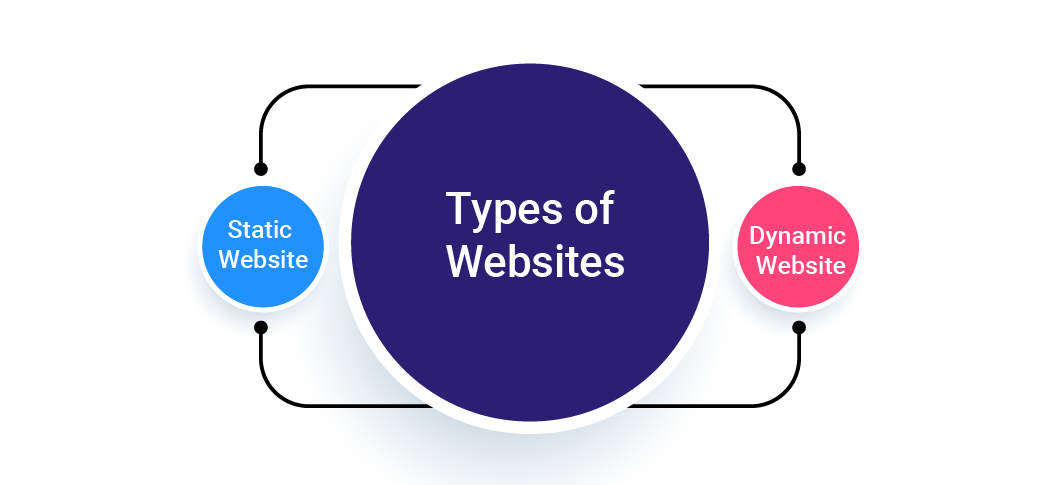
Choosing between a static and dynamic website is a pivotal decision that can significantly impact the effectiveness and functionality of your digital platform. Therefore, understanding their differences is critical for making the right decision based on your objectives and technical resources.
In this exploration, we will navigate the characteristics of Static and Dynamic approaches. We’ll also shed light on their distinct features and primary differences to help you make an informed decision tailored to your unique needs. Let’s dive in!
What is a Static Website?
A static website is similar to a digital brochure, offering a pre-built and fixed set of information delivered to users “as is.”
A static website consists of fixed, pre-built web pages with constant and unchanged content until manually updated.
These websites are typically created using HTML (Hypertext Markup Language) and CSS (Cascading Style Sheets) to define the pages’ structure, design, colour and visuals.
Architecture of Static Website
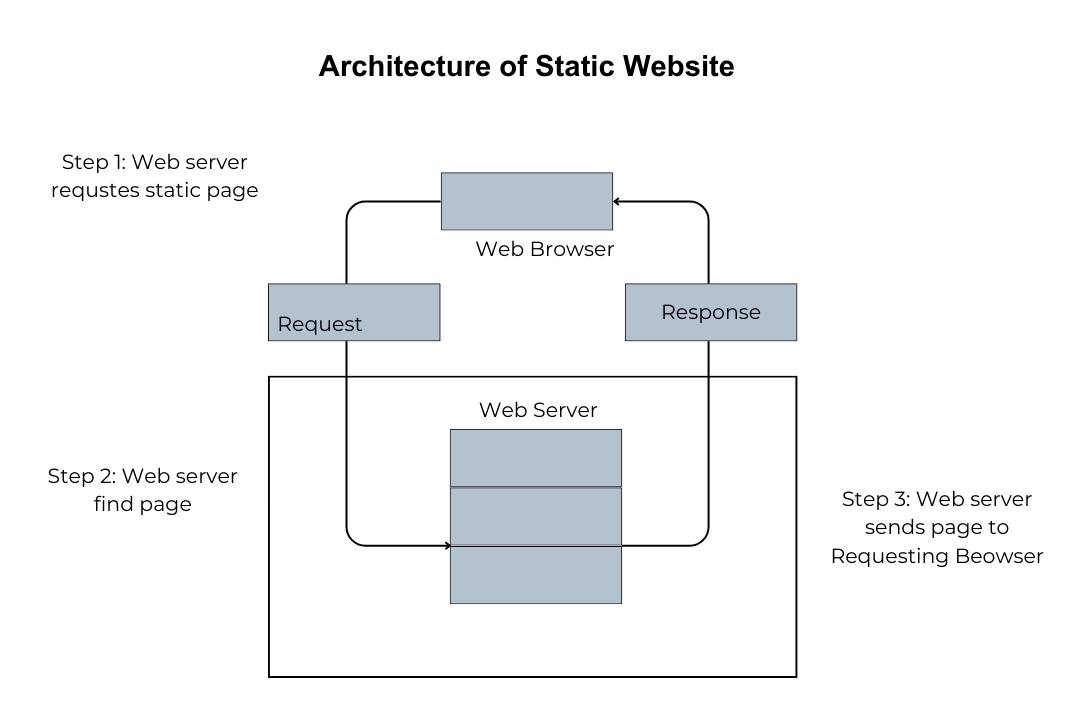 [Source: geeksforgeeks]
[Source: geeksforgeeks]
With fast loading times and enhanced security due to fewer dynamic components, static websites are well-suited for scenarios where content remains stable over time, such as personal portfolios or small business sites.
While they may lack the interactive features of dynamic counterparts, the efficiency and cost-effectiveness of static websites make them an excellent choice for those seeking a straightforward online presence without frequent updates or dynamic functionalities.
Key Characteristics of a Static Website
Static sites present a predetermined structure to all users, lacking interactive elements that respond dynamically to user inputs. The simplicity of static websites lies in their straightforward HTML/CSS structure, making them easy to create, host, and maintain.
Let us now see the features of Static websites that make them a practical choice for specific use cases where simplicity and efficiency are prioritised:
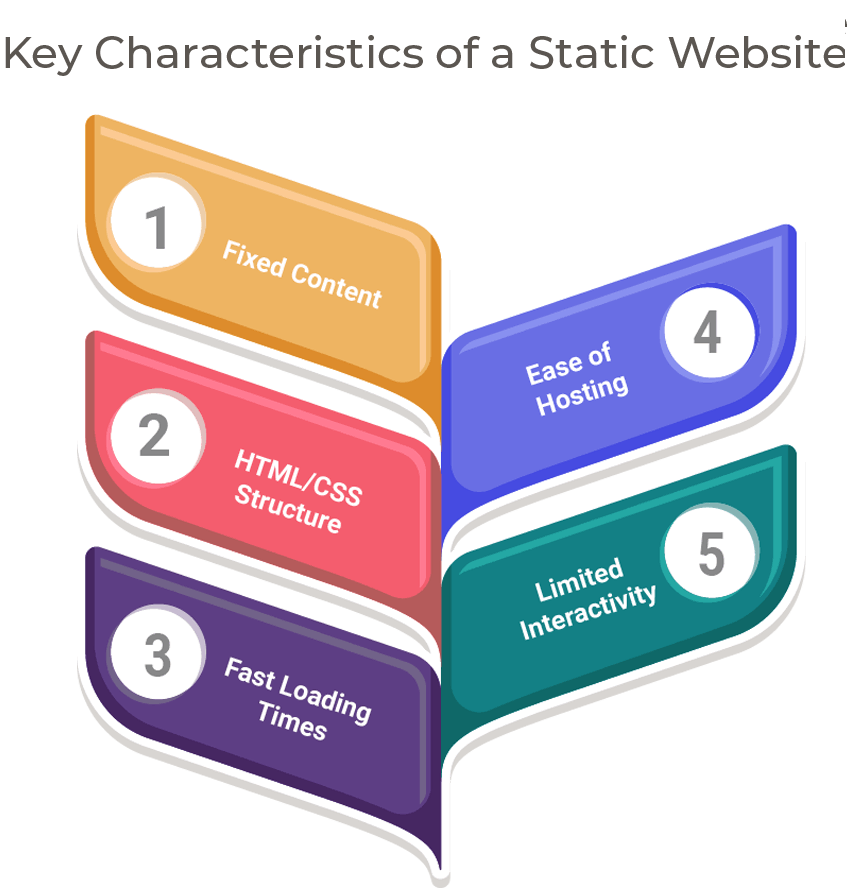
- Fixed Content
The content on a static website is unchanging and remains constant until manually updated. Each page has a predefined structure and does not adapt dynamically based on user interactions. - HTML/CSS Structure
Static websites are primarily built using HTML for content markup and CSS for styling. The structure of each page is defined through HTML, while CSS controls the visual presentation and layout. - Fast Loading Times
Due to the absence of dynamic content generation, static websites typically load quickly. The pre-rendered pages contribute to a fast and responsive user experience, making them suitable for scenarios where speed is crucial. - Ease of Hosting
Hosting static websites is straightforward and often requires minimal server resources. This simplicity makes them cost-effective and accessible for small businesses with limited tech expertise. - Limited Interactivity
Interactivity on static websites is restricted to what is directly coded into the HTML and CSS. They are less suitable for features that involve server-side processing, user input handling, or frequent content updates.’
Advantages and Disadvantages of Static Website
Static websites offer simplicity, speed, and cost-effectiveness but come with limitations in terms of interactivity, scalability, and the ability to implement complex features. Let’s check them out below:
| Advantages of Static Websites | Disadvantages of Static Websites |
| Simplicity: Easy to create and maintain, suitable for beginners. | Limited Interactivity: Dynamic features are restricted. |
| Fast Loading Times: Pre-built pages result in quick loading. | Scalability Challenges: Manual creation can hinder scaling. |
| Cost-Effective Hosting: Requires minimal server resources. | Cumbersome Content Updates: Regular updates are time-consuming. |
| Enhanced Security: Fewer dynamic components strengthen security. | Difficulty with Complex Features: Advanced features are challenging. |
| Low Maintenance: Changes are infrequent, reducing maintenance. | Less Visitor Engagement: Limited interactivity may lead to lower engagement. |
| Reliability: Not dependent on databases, providing consistent availability. | Dependency on Web Developer: Technical expertise is often needed. |
What is a Dynamic Website?
A dynamic website is an interactive and versatile online platform that delivers content tailored to individual users or situations.
A dynamic website is a web platform characterised by its ability to generate and display content on the fly, responding to user interactions or real-time data.
Dynamic sites employ server-side technologies such as PHP, Python, or ASP.NET, allowing for the creation of interactive and personalised experiences. These websites often integrate with databases to store and retrieve dynamic content, enabling features such as user authentication, forms, and personalised recommendations.
Architecture of Dynamic Website
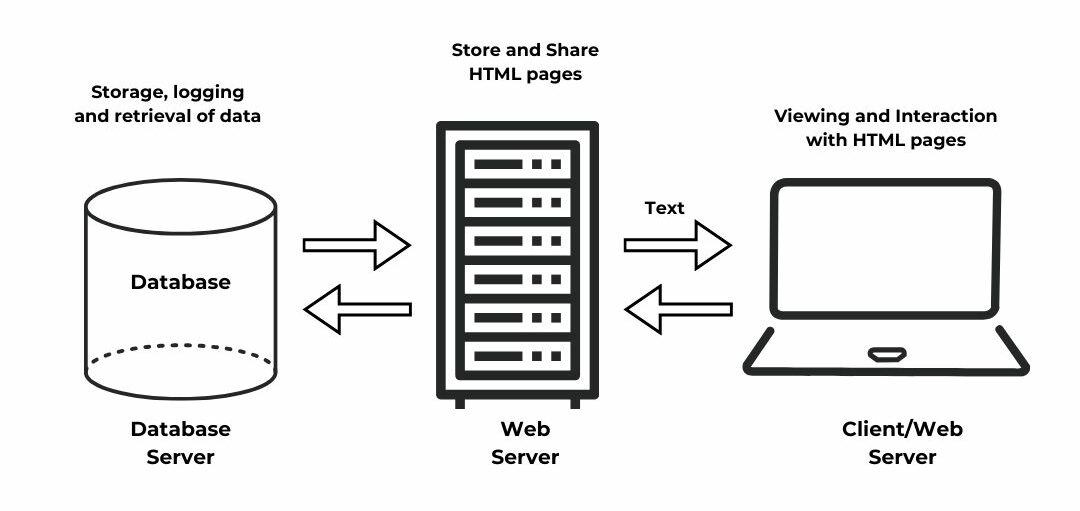
[Source: geeksforgeeks]
While dynamic websites offer advanced features, they may require more resources and technical expertise for development and maintenance compared to static counterparts.
The selection between static and dynamic websites depends primarily on the specific needs and goals of the website owner, ranging from simplicity and speed to interactivity and scalability.
| Dynamic Websites facilitate Content Management Systems (CMS)!
Many dynamic websites utilise CMS platforms like WordPress, Joomla, or Drupal. CMS simplifies content creation, updates, and management, enabling non-technical users to maintain and modify the site. |
Key Characteristics of a Dynamic Website
Dynamic websites are known for their exceptional website design, scalability, making them suitable for large-scale projects with extensive content or those anticipating future growth. Its versatility extends to complex functionalities, providing a dynamic and engaging user experience.
Dynamic websites exhibit several key characteristics that set them apart from static counterparts. Let’s check them out below:
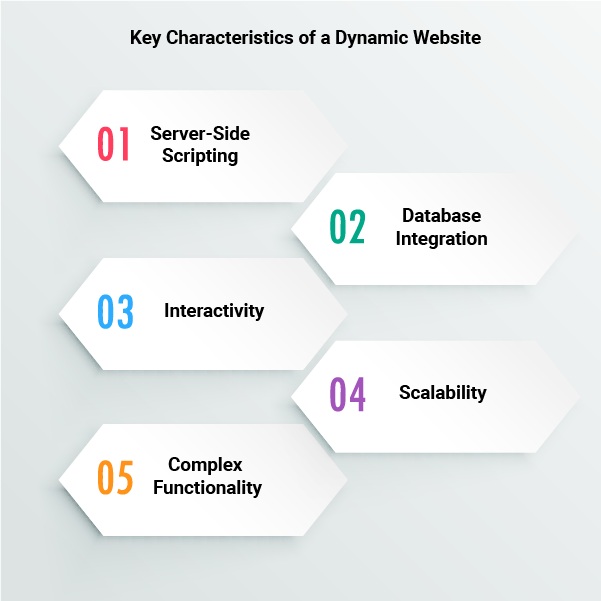
- Server-Side Scripting
Dynamic websites utilise server-side scripting languages such as PHP, Python, Ruby, or ASP.NET to generate content dynamically. These scripts execute on the server, creating HTML content sent to the user’s browser. - Database Integration
Dynamic websites often employ databases (e.g., MySQL, PostgreSQL) to store and retrieve dynamic content, user information, and other data. This enables efficient data management and retrieval. - Interactivity
One of the primary characteristics of dynamic websites is their ability to respond to user interactions. This interactivity allows for features like forms, user authentication, and real-time updates, enhancing user engagement. - Scalability
Dynamic websites are more scalable than static sites, allowing for adding new content and features without manually creating individual pages. This scalability is particularly beneficial for large websites or those expecting growth. - Complex Functionality
Dynamic websites can incorporate complex functionalities such as eCommerce capabilities, forums, social networking features, and multimedia content. This versatility of dynamic sites makes them suitable for a wide range of purposes.
Advantages and Disadvantages of Dynamic Website
Dynamic websites offer potent features and interactivity but come with considerations such as development complexity, resource requirements, security challenges, and the need for ongoing maintenance. Let’s find out below:
| Advantages of Dynamic Websites | Disadvantages of Dynamic Websites |
| Interactivity: Allows for dynamic user engagement features. | Complex Development: Requires advanced development skills. |
| Personalisation: Can deliver personalised content. | Resource Intensive: May require more server resources. |
| Scalability: Easily accommodates growing content. | Security Concerns: Introduces potential security risks. |
| Complex Functionality: Supports advanced features. | Maintenance Challenges: Regular updates and maintenance are required. |
| Real-Time Updates: Displays timely information. | Slower Loading Times: May experience slower load times. |
| Content Management Systems (CMS): Simplifies content management. | Dependency on CMS: Introduces dependency on specific CMS features. |
| Adaptability: Easily adapts to changing requirements. | Learning Curve for Users: Users may need to learn CMS functionality. |
| Database Integration: Efficient storage and retrieval of data. | Compatibility Issues: Ensuring compatibility can be challenging. |
Major Difference between Static and Dynamic Website
Static and dynamic websites are distinguished in their structure, content delivery, and interactivity. Below are the key differences between static and dynamic websites:
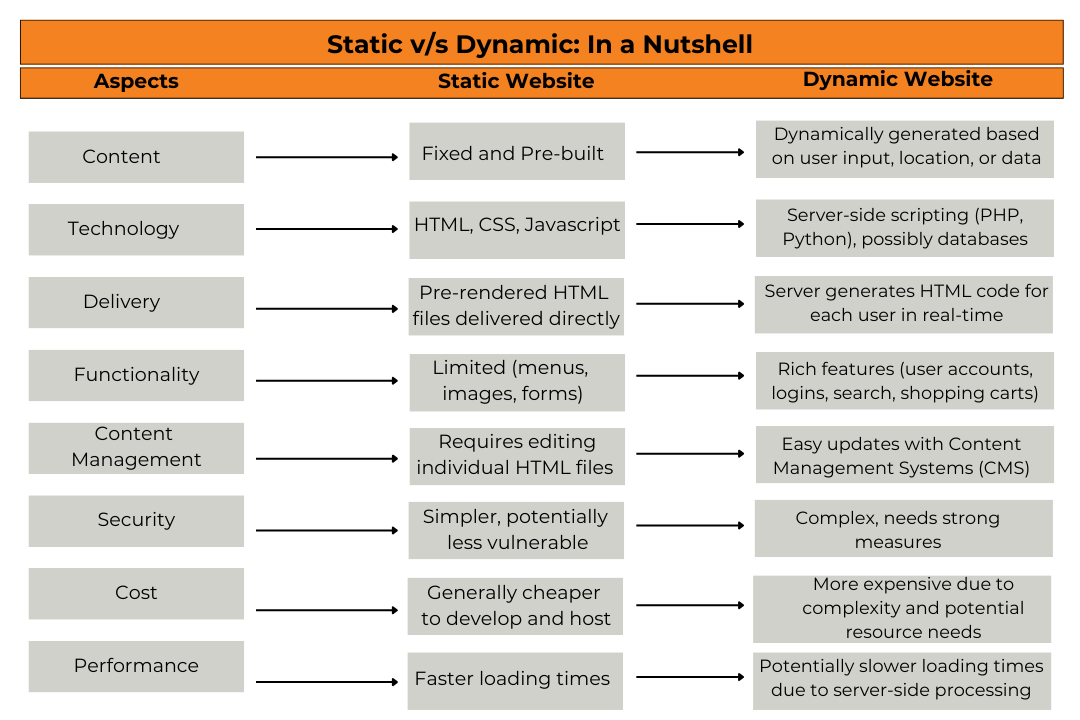
The major difference between a static and dynamic website lies in how content is generated and delivered to users.
A static website consists of fixed, unchanging pages written in HTML and displaying the same content to every visitor. These sites are easy to create and host but lack the flexibility to adapt to user interactions or input.
On the other hand, dynamic websites use server-side technologies such as PHP, Python, or ASP.NET to generate content on-the-fly based on user requests.
This enables dynamic websites to deliver personalised and interactive experiences, allowing users to engage with dynamic content, submit forms, and receive customised information.
While static websites are suitable for simple informational purposes, dynamic websites are better suited for applications requiring frequent updates, user interactions, and data-driven content.
Understanding Which Option is Right for You: Static v/s Dynamic
| Decision Factors for Selection between Static and Dynamic Website | ||
| Factors | Static Website | Dynamic Website |
| Content Nature | For stable content that changes infrequently. | When real-time updates, user interactivity, or personalised content are essential. |
| Budget and Expertise | Cost-effective, suitable for beginners | May require a higher budget and more technical expertise. |
| Scalability and Growth | Challenging to scale for large websites. | More scalable, suitable for growing content and user bases. |
| Interactivity Requirements | Limited interactive features. | Robust interactivity, suitable for complex functionalities. |
| Maintenance Considerations | Low maintenance. | Regular updates and potential security considerations. |
Determining whether a static or dynamic website is the right choice involves carefully considering your needs and goals. A static website might be ideal if you envision a straightforward online presence with stable content, quick loading times, and minimal maintenance.
This option is cost-effective and suits scenarios where content changes infrequently. On the other hand, if your vision encompasses interactivity, real-time updates, and a more feature-rich platform, a dynamic website is likely the better fit.
This choice offers versatility, scalability, and the ability to implement complex functionalities, making it suitable for larger projects or those with evolving content requirements.
Evaluating factors such as budget, technical expertise, and the nature of your content is crucial in making the right decision. A comprehensive understanding of these options ensures that your website aligns seamlessly with your goals, delivering an optimal online experience for your audience.
Hence, ask yourself these key questions:
- What is the primary purpose of your website? (Informational vs. interactive)
- How often will your content need updating?
- How vital are personalisation and user interaction?
- What is your budget, and what are your technical resources?
Note: For the precise selection of the type of website for your business, it is crucial to have a detailed know-how of the website development cost. The development price will help you immensely in making the choice that fits in your budget, while catering to your requirements.
[You can also consider our Website Design Cost Calculator to get a rough estimate of building your website in Australia]
| Is it possible to combine both the methods?
Certainly! Remember, it’s possible to have a Hybrid Approach, with some of your pages being Static (e.g., contact, about us) and others Dynamic (e.g., blog, product listings for an online store). Examples:
|
Conclusion
Both static and dynamic websites have their merits, and the right choice depends on your needs. Carefully evaluating factors such as content type, interactivity, scalability, and budget will guide you toward the option that aligns with your goals.
A detailed discussion with a proficient website design and development company can cater to your needs. They can recognise the nuanced differences, tailoring solutions that meet your expectations and lay the foundation for your business’s robust and future-ready online presence.
Hence, whether you choose the simplicity of a static website or the dynamic functionality of a CMS-driven site, the key is to create a web presence that effectively serves your audience and objectives.













